
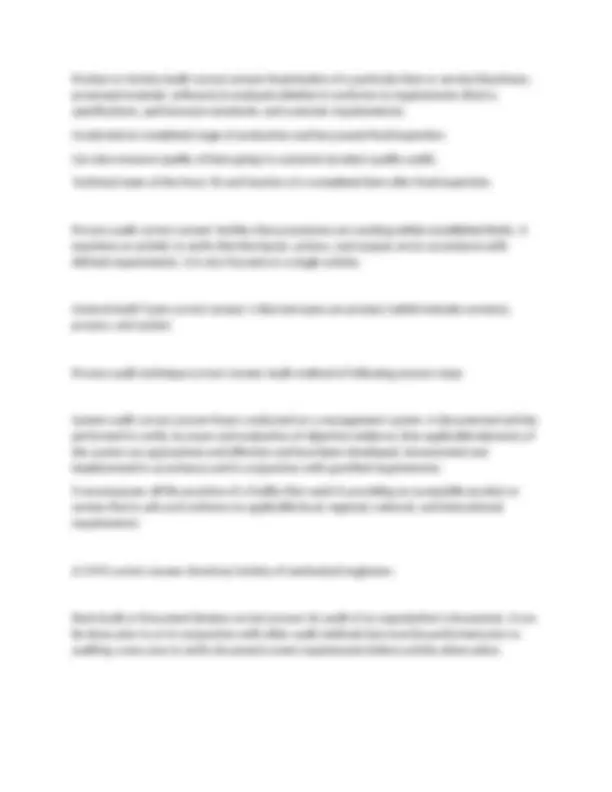
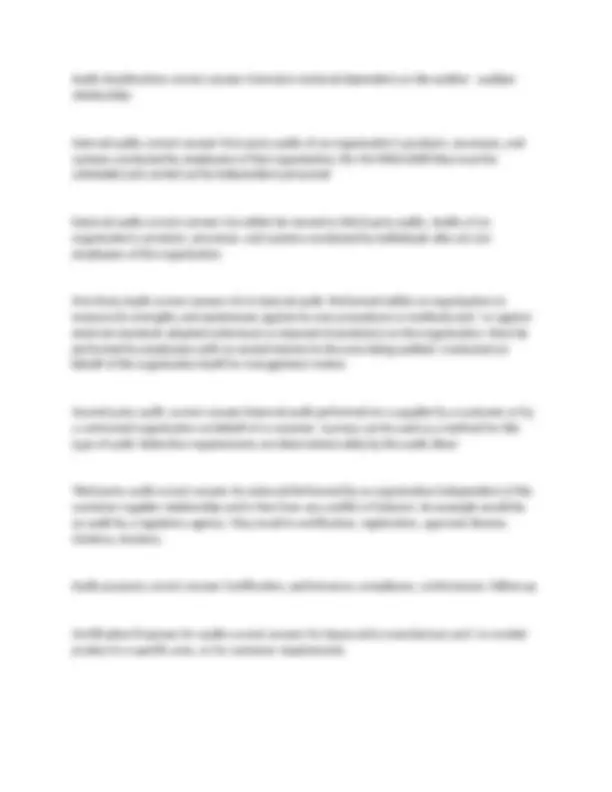
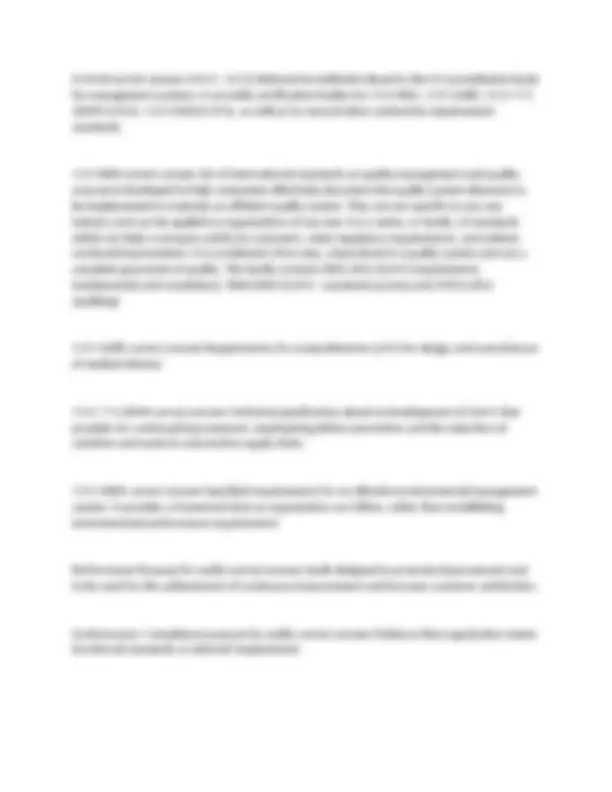
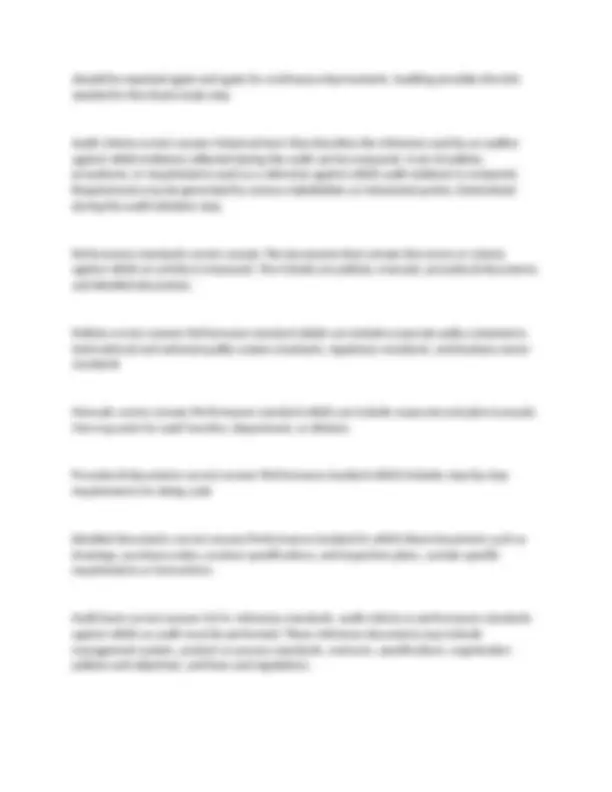
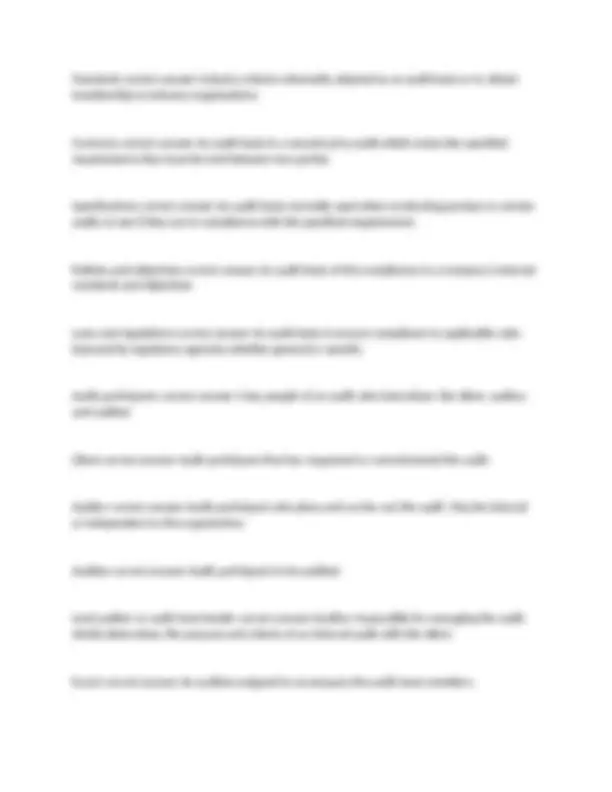
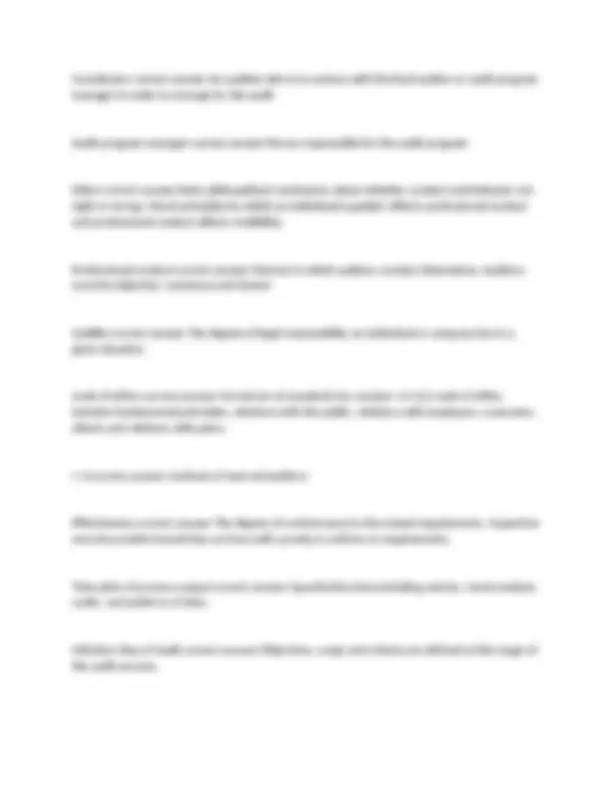
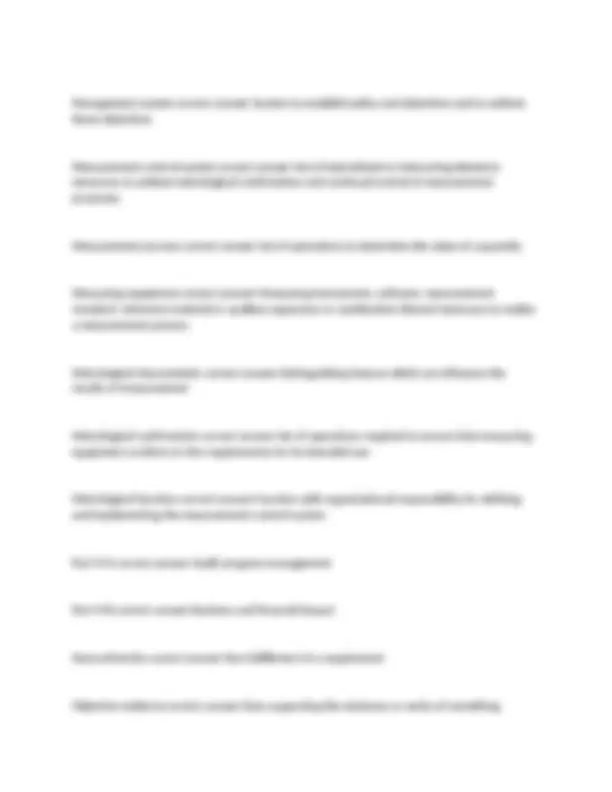
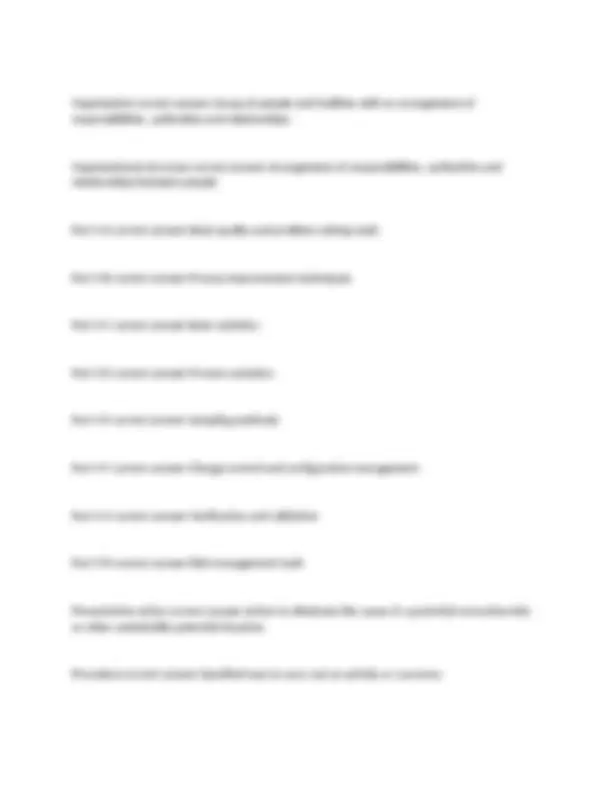
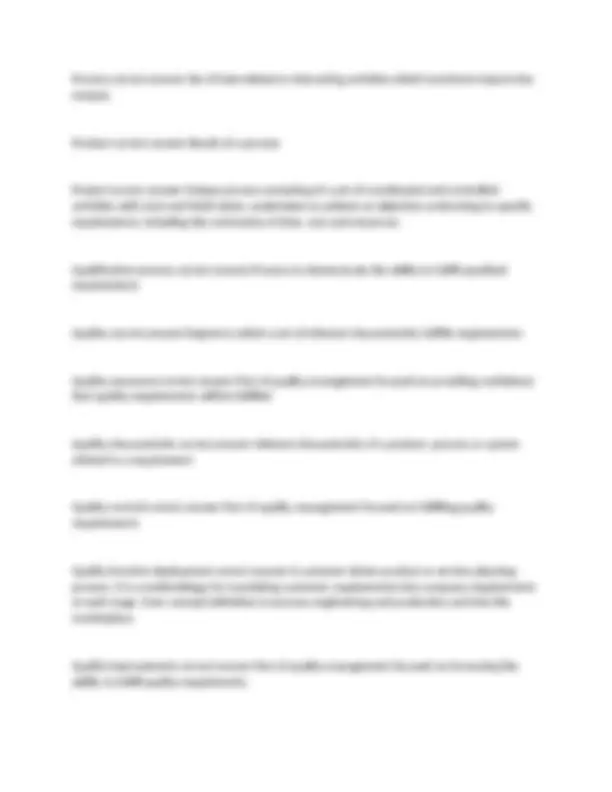
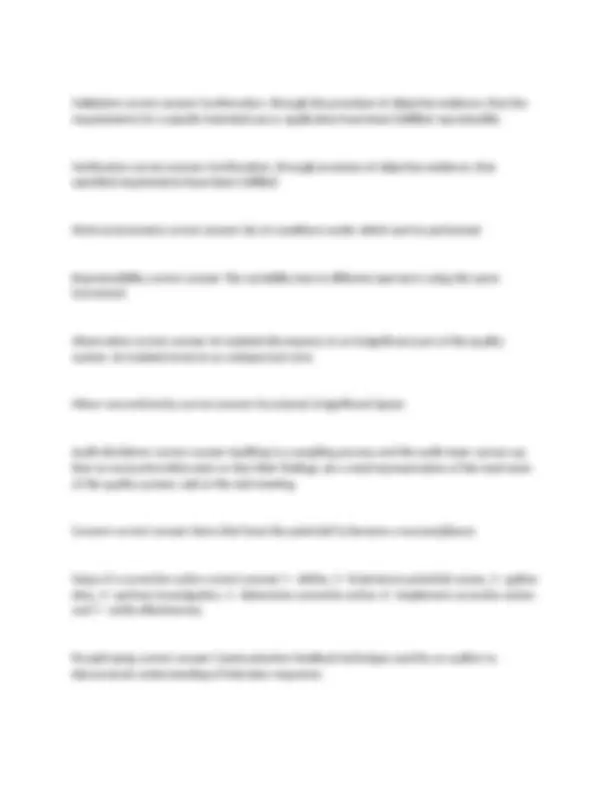
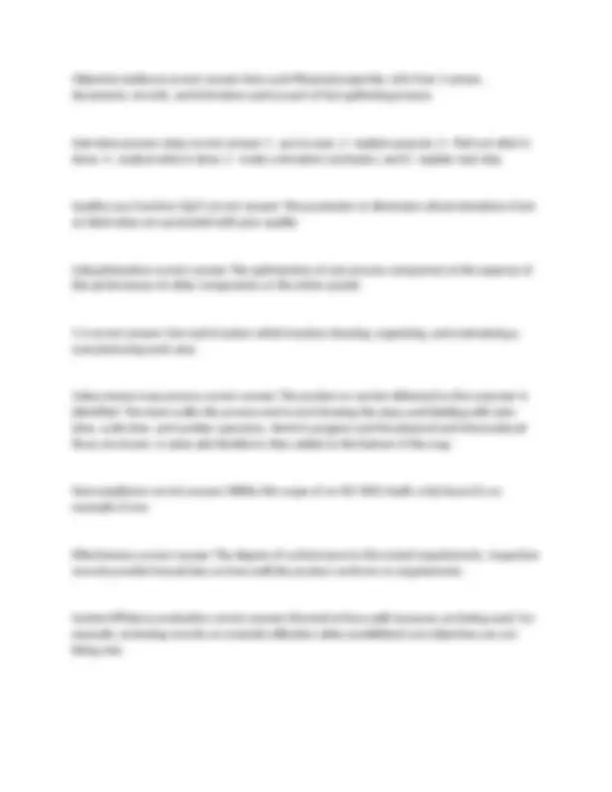
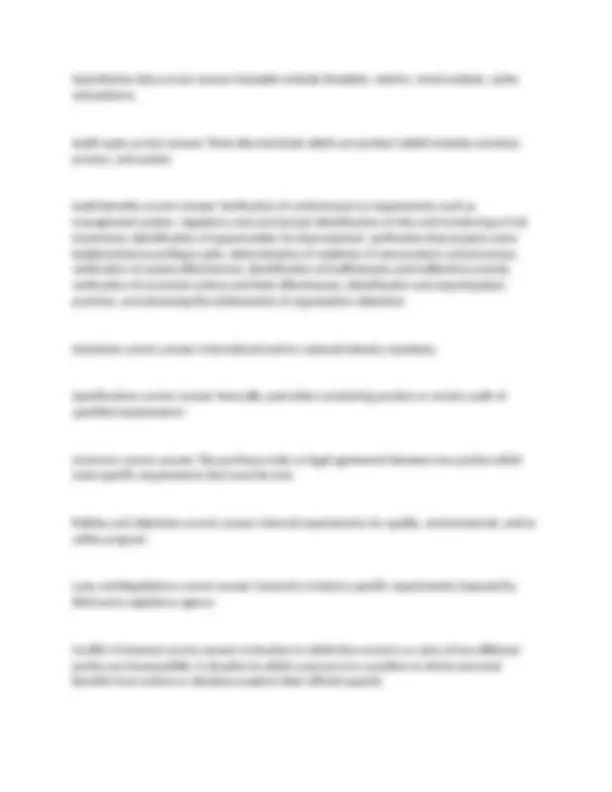
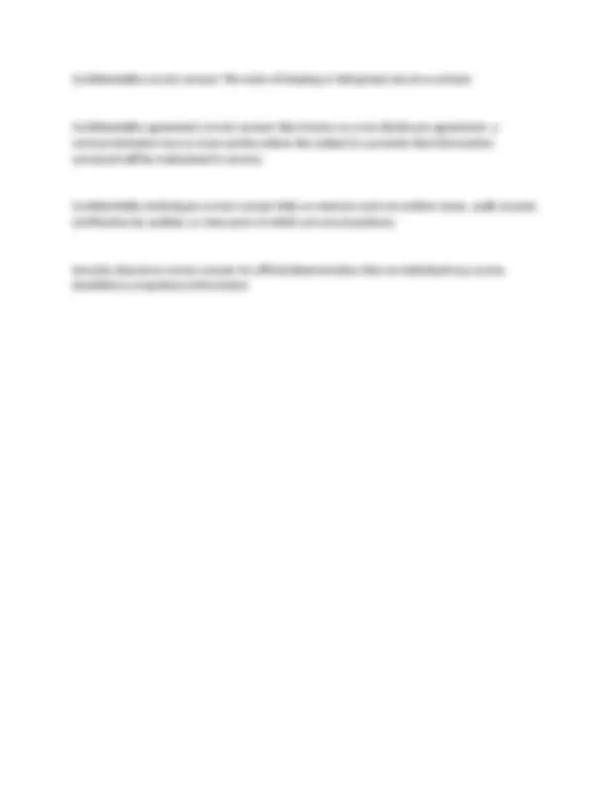


Study with the several resources on Docsity

Earn points by helping other students or get them with a premium plan


Prepare for your exams
Study with the several resources on Docsity

Earn points to download
Earn points by helping other students or get them with a premium plan
Community
Ask the community for help and clear up your study doubts
Discover the best universities in your country according to Docsity users
Free resources
Download our free guides on studying techniques, anxiety management strategies, and thesis advice from Docsity tutors
A glossary of terms and definitions for the ASQ CQA exam, covering auditing, quality management systems, and standards like ISO 9000, ISO 19011, and AS9100. It includes audit types (internal, external, product, process, system), purposes (certification, performance, compliance), and audit process elements. Definitions of quality management terms like competence, conformity, and continual improvement are also provided, making it a valuable resource for CQA exam preparation and understanding quality auditing principles. This resource enhances understanding and preparation for quality auditing certifications and practices, serving as a quick reference for quality professionals and students, offering clear explanations of key concepts and terminology. It is structured for easy navigation and quick access to information, making it an indispensable tool for quality assurance and auditing.
Typology: Exams
1 / 21

This page cannot be seen from the preview
Don't miss anything!














ASQ correct answer American Society for Quality ISO 19011:2011 correct answer sets out guidance on internal and external audits of quality management systems ISO 9000:2015 correct answer Describes the fundamental concepts and principles of quality management which are universal Audit correct answer Systematic, independent and documented process for obtaining evidence and evaluating it objectively to determine the extent to which the criteria are fulfilled Audit client correct answer Organization or person requesting an audit. Determines the scope of the audit. Jointly determines the purpose and criteria of an internal audit with the lead auditor. Audit conclusion correct answer Outcome of an audit, provided by the audit team after consideration of the audit objectives and all audit findings Audit criteria correct answer Set of policies, procedures or requirements Audit evidence correct answer Records, statements of fact or other info, which are relevant to the audit criteria and verifiable Audit findings correct answer Results of the evaluation of the collected evidence against criteria Audit plan correct answer Description of the activities and arrangements for an audit
Audit Program correct answer Set of one or more audits planned for a specific time frame and directed towards a specific purpose Audit scope correct answer Extent and boundaries of an audit. Normally defines the organizations and time period for the audit. Can include physical locations, departments, products, processes, or systems, exclusions, timelines, relevant polices or procedures, and applicable regulations or contracts. Audit team correct answer One or more auditors conducting an audit, supported if needed by technical experts Auditee correct answer Organization being audited Auditor correct answer Person with the competence to conduct an audit Part I correct answer Auditing fundamentals Part I A correct answer Types of quality audits Part I B correct answer Purpose and scope of audits Part I C correct answer Criteria to audit against Part I D correct answer Roles and responsibilities of audit participants Part I E correct answer Professional conduct and consequences for auditors
Audit classifications correct answer Internal or external dependent on the auditor - auditee relationship Internal audits correct answer First party audits of an organization's products, processes, and systems conducted by employees of that organization. Per ISO 9000:2008 they must be scheduled and carried out by independent personnel External audits correct answer Can either be second or third party audits. Audits of an organization's products, processes, and systems conducted by individuals who are not employees of the organization. First Party Audit correct answer A K A internal audit. Performed within an organization to measure its strengths and weaknesses against its own procedures or methods and / or against external standards adopted (voluntary) or imposed (mandatory) on the organization. Must be performed by employees with no vested interest in the area being audited. Conducted on behalf of the organization itself for management review. Second party audit. correct answer External audit performed on a supplier by a customer or by a contracted organization on behalf of a customer. Surveys can be used as a method for this type of audit. Retention requirements are determined solely by the audit client Third party audit correct answer An external Performed by an organization independent of the customer-supplier relationship and is free from any conflict of interest. An example would be an audit by a regulatory agency. May result in certification, registration, approval, license, citations, etcetera. Audit purposes correct answer Certification, performance, compliance, conformance, follow-up Certification Purposes for audits correct answer For Approval to manufacture and / or market product in a specific area, or for customer requirements
A N A B correct answer A N S I - A S Q National Accreditation Board is the U S accreditation body for management systems. It accredits certification bodies for I S O 9001, I S O 13485, I S O / T S 16949 Q M Ss, I S O 14001 E M Ss, as well as for several other conformity requirements standards. I S O 9000 correct answer Set of international standards on quality management and quality assurance developed to help companies effectively document the quality system elements to be implemented to maintain an efficient quality system. They are not specific to any one industry and can be applied to organizations of any size. It is a series, or family, of standards which can help a company satisfy its customers, meet regulatory requirements, and achieve continual improvement. It is considered a first step, a base level of a quality system and not a complete guarantee of quality. The family contains 9001:2015 (Q M S requirements, fundamentals and vocabulary), 9004:2009 (Q M S - sustained success) and 19011: (auditing) I S O 13485 correct answer Requirements for comprehensive Q M S for design and manufacture of medical devices I S O / T S 16949 correct answer Technical specification aimed at development of Q M S that provides for continual improvement, emphasizing defect prevention and the reduction of variation and waste in automotive supply chain. I S O 14001 correct answer Specified requirements for an effective environmental management system. It provides a framework that an organization can follow, rather than establishing environmental performance requirements Performance Purpose for audits correct answer Audit designed to promote improvement and to be used for the achievement of continuous improvement and increase customer satisfaction. Conformance / compliance purpose for audits correct answer Evidence that organization meets its internal standards or external requirements
Characteristic correct answer Distinguishing feature Competence correct answer Demonstrated personal attributes and demonstrated ability to apply knowledge and skills Concession correct answer Permission to use or release a product that does not conform to specified requirements Conformity correct answer Fulfillment of a requirement Continual improvement correct answer Recurring activity to increase the ability to fulfill requirements Correction correct answer Action to eliminate a detected nonconformity Corrective action correct answer Action to eliminate the cause of a detected nonconformity or other undesirable situation Customer correct answer Organization or person that receives a product Customer satisfaction correct answer Customer's perception of the degree to which the customer's requirements have been fulfilled Audit scope correct answer The extent and boundaries of an audit. Normally includes a description of the physical locations, organizational units, activities and processes, and time period covered. May specify areas not to be included as well. Deming cycle correct answer A K A: P D C A, P D S A, or shewhart cycle. The plan-do-check (study)-act cycle is a 4 step model for carrying out change. Just as a circle has no end, this cycle
should be repeated again and again for continuous improvement. Auditing provides the info needed for the check-study step. Audit criteria correct answer Universal term that describes the reference used by an auditor against which evidence collected during the audit can be compared. A set of policies, procedures, or requirements used as a reference against which audit evidence is compared. Requirements may be generated by various stakeholders or interested parties. Determined during the audit initiation step. Performance standards correct answer The documents that contain the norms or criteria against which an activity is measured. The 4 levels are policies, manuals, procedural documents, and detailed documents. Policies correct answer Performance standard which can include corporate policy statements, international and national quality system standards, regulatory standards, and business sector standards Manuals correct answer Performance standard which can include corporate and plant manuals. One may exist for each function, Department, or division. Procedural documents correct answer Performance standard which includes step-by-step requirements for doing a job Detailed documents correct answer Performance standard in which these documents such as drawings, purchase orders, product specifications, and inspection plans, contain specific requirements or instructions. Audit basis correct answer A K A: reference standards, audit criteria or performance standards against which an audit must be performed. These reference documents may include management system, product or process standards, contracts, specifications, organization policies and objectives, and laws and regulations.
Coordinator correct answer An auditee who is in contact with the lead auditor or audit program manager in order to arrange for the audit Audit program manager correct answer Person responsible for the audit program Ethics correct answer Basic philosophical conclusions about whether conduct and behavior are right or wrong. Moral principles by which an individual is guided. Affects professional conduct and professional conduct affects credibility. Professional conduct correct answer Manner in which auditors conduct themselves. Auditors must be objective, courteous and honest Liability correct answer The degree of legal responsibility an individual or company has in a given situation. Code of ethics correct answer Formal set of standards for conduct. A S Q's code of ethics includes fundamental principles, relations with the public, relations with employers, customers, clients and relations with peers. I I A correct answer Institute of Internal Auditors Effectiveness correct answer The degree of conformance to the stated requirements. Inspection records provide factual data on how well a product confirms to requirements. Time plots of process output correct answer Quantitative data including metrics, trend analysis, cycles, and patterns of data. Initiation Step of Audit correct answer Objectives, scope and criteria are defined at this stage of the audit process.
Audit purpose correct answer Performed for two basic reasons: to determine if requirements are being met and to determine if there are opportunities for improvement Part II A correct answer Audit prep and planning Part II B correct answer Auditbperformance Part II C correct answer Audit reporting Part II D correct answer Audit follow up and closure Defect correct answer No -fulfillment of a requirement related to an intended or specified use Dependability correct answer Collective term used to describe the availability performance and its influencing factors: reliability, performance, maintain ability performance and maintenance support performance. Design and development correct answer Set of processes that transforms requirements into specified characteristics or into the specification of a product, process, or system Deviation permit correct answer Permission to depart from the originally specified requirements of a product prior to realization Document correct answer Information and it's supporting medium Effectiveness correct answer Extent to which planned activities are realized and planned results achieved Efficiency correct answer Relationship between the result achieved and the resources used
Management system correct answer System to establish policy and objectives and to achieve those objectives Measurement control system correct answer Set of interrelated or interacting elements necessary to achieve metrological confirmation and continual control of measurement processes Measurement process correct answer Set of operations to determine the value of a quantity Measuring equipment correct answer Measuring instruments, software, measurement standard, reference material or auxiliary apparatus or combination thereof necessary to realize a measurement process Metrological characteristic correct answer Distinguishing feature which can influence the results of measurement Metrological confirmation correct answer Set of operations required to ensure that measuring equipment confirms to the requirements for its intended use Metrological function correct answer Function with organizational responsibility for defining and implementing the measurement control system Part IV A correct answer Audit program management Part IV B correct answer Business and financial impact Nonconformity correct answer Non-fulfillment of a requirement Objective evidence correct answer Data supporting the existence or verity of something
Organization correct answer Group of people and facilities with an arrangement of responsibilities, authorities and relationships Organizational structure correct answer Arrangement of responsibilities, authorities and relationships between people Part V A correct answer Basic quality and problem solving tools Part V B correct answer Process improvement techniques Part V C correct answer Basic statistics Part V D correct answer Process variation Part V E correct answer Sampling methods Part V F correct answer Change control and configuration management Part V G correct answer Verification and validation Part V H correct answer Risk management tools Preventative action correct answer Action to eliminate the cause of a potential nonconformity or other undesirable potential situation Procedure correct answer Specified way to carry out an activity or a process
Quality management correct answer Coordinated activities to direct and control an organization with regard to quality Quality management system correct answer Management system to direct and control an organization with regard to quality Quality manual correct answer Document specifying the quality management system of an organization Quality objective correct answer Something sought, or aimed for, related to quality Quality plan correct answer Document specifying which procedures and associated resources shall be applied by whom and when to a specific project, product, process or contract Quality planning correct answer Part of quality management focused on setting quality objectives and specifying necessary operational processes and related resources to fulfill the quality objectives Quality policy correct answer Overall intentions and direction of an organization related to quality as formally expressed by top management Record correct answer Document stating results achieved or providing evidence of activities performed Regrade correct answer Alteration of grade of a non-conforming product in order to make it conform to requirements differing from the initial ones Release correct answer Permission to proceed to the next stage of a process
Repair correct answer Action on a nonconforming product to make it acceptable for the intended use Requirement correct answer Need or expectation that is stated, generally implied or obligatory Review correct answer Activity undertaken to determine the suitability, adequacy and effectiveness of the subject matter to achieve established objectives Rework correct answer Action on a nonconforming product to make it conform to the requirements Scrap correct answer Action on a nonconforming product to preclude its originally intended use Specification correct answer Document stating requirement Supplier correct answer Organization or person that provides a product System correct answer Set of interrelated or interacting elements Technical expert correct answer Person who provides specific knowledge or expertise to the audit team Test correct answer Determination of one or more characteristics according to a procedure Top management correct answer Person or group of people who directs and controls an organization at the highest level Traceability correct answer Ability to trace the history, application or location of that which is under consideration
Objective evidence correct answer Data such Physical properties, info from 5 senses, documents, records, and interviews used as part of fact gathering process Interview process steps correct answer 1 - put at ease, 2 - explain purpose, 3 - find out what is done, 4 - analyze what is done, 5 - make a tentative conclusion, and 6 - explain next step Quality Loss Function (QLF) correct answer The parameter or dimension whose deviations from an ideal value are associated with poor quality Suboptimization correct answer The optimization of one process component at the expense of the performance of other components or the entire system 5 S correct answer One tool in kaizen which involves cleaning, organizing, and maintaining a manufacturing work area Value stream map process correct answer The product or service delivered to the customer is identified. The team walks the process end to end drawing the steps and labeling with take time, cycle time, and number operators. Work in progress and the physical and informational flows are drawn. A value add timeline is then added at the bottom of the map. Noncompliance correct answer Within the scope of an ISO 9001 Audit a trip hazard is an example of one Effectiveness correct answer The degree of conformance to the stated requirements. Inspection records provide factual data on how well the product conforms to requirements. System Efficiency evaluation correct answer Directed at how well resources are being used. For example, reviewing records on material utilization when established cost objectives are not being met.
Quantitative data correct answer Examples include timeplots, metrics, trend analysis, cycles and patterns. Audit types correct answer Three discrete kinds which are product (which includes services), process, and system. Audit benefits correct answer Verification of conformance to requirements such as management system, regulatory and contractual, identification of risks and monitoring of risk treatments, identification of opportunities for improvement, verification that projects were implemented according to plan, determination of readiness of new products and processes, verification of system effectiveness, identification of inefficiencies and ineffective controls, verification of corrective actions and their effectiveness, identification and reporting best practices, and advancing the achievement of organization objectives Standards correct answer International and/or national industry mandates. Specifications correct answer Normally used when conducting product or service audit of specified requirements Contracts correct answer The purchase order or legal agreement between two parties which state specific requirements that must be met. Policies and objectives correct answer Internal requirements for quality, environmental, and/or safety program Laws and Regulations correct answer General or industry specific requirements imposed by third party regulatory agency Conflict of interest correct answer A situation in which the concerns or aims of two different parties are incompatible. A situation in which a person is in a position to derive personal benefits from actions or decisions made in their official capacity